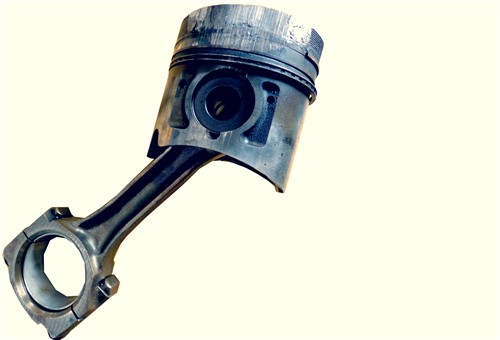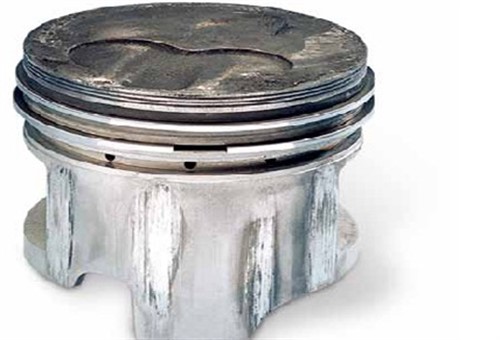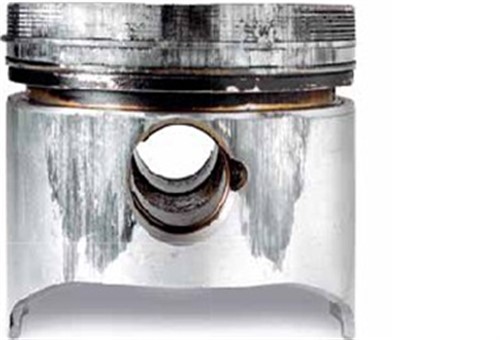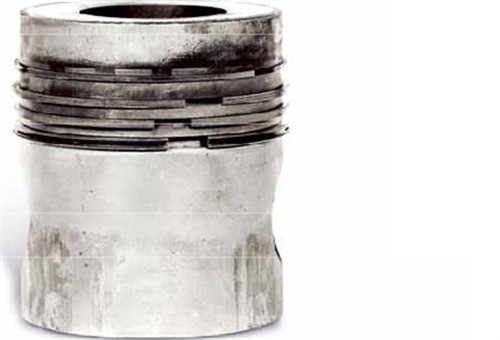
In the previous article in this series, we discussed the anatomy of pistons in some depth and detail to provide a suitable background against which to judge engine failures as the result of insufficient piston to cylinder wall clearances. However, the signs and symptoms of piston failures caused by a lack of cylinder wall lubrication and insufficient piston to cylinder wall clearances are very similar, if not always identical. For instance, a lack of lubrication can cause reduced clearances through excessive expansion of pistons caused by increased friction, while insufficient clearances can displace the lubricating oil film on the cylinder wall, which then causes piston seizures.
As a practical matter, though, making a distinction between these two causes of piston and engine failure can be challenging and confusing, and even more so if you do not deal with these kinds of failures regularly. Therefore, this article will deal exclusively with the specific causes of the three most common types of piston failure as the result of reduced or insufficient piston to cylinder wall (PTW) clearances. Before we get to specifics though, let us look at a general overview of piston seizures by describing-
If we ignore a lack of cylinder wall lubrication and engine overheating as primary causes of piston seizures, we are left with only three possible causes of piston seizures. Moreover, all three of these causes relate to the fact that pistons generally a) expand twice as much as cylinders and b) that pistons begin to expand long before cylinders do.
Thus, since pistons expand both more and faster than cylinders, all defects, abnormalities, or distortions of cylinder walls can potentially affect PTW clearances. For instance, if PTW clearances are reduced to less than minimum allowable thresholds, the only effect might be some highly polished spots on piston skirts and the cylinder walls developing. This is a typical symptom if the expanding piston partially displaces the lubricating oil film.
If, however, the PTW clearances are eliminated on one or more pistons, the surfaces of the expanding pistons break through the lubricating oil film, which results in boundary lubricating conditions. Thus, since there is direct metal-to-metal contact between the piston and the cylinder wall, the result is usually a catastrophic failure of the pistons as they seize in the cylinder bores.
In most cases, this merely results in the engine shutting off because of the increased friction, but in other cases, the sudden seizure of the pistons result in the pistons disintegrating, connecting rods bending or breaking, or even crankshafts breaking if the engine had been running at high speeds and/or loads. In such cases, it is not uncommon that the flailing connecting rods knock holes in the cylinder block, or that valves and cylinder heads are destroyed by pieces of fractured pistons flying around the cylinder bores at very high velocities.
If the engine had not disintegrated, making diagnosis of the problem all but impossible, the symptoms of piston seizures are usually characterized by two features, these being bright, highly polished pressure points that gradually change from being bright and smooth to being dark and discoloured towards the edges of the wear spots. The other typical symptom is the presence of rough seizure marks either around the entire circumference of the piston, or smaller seizure marks that are placed equidistantly on both the thrust and non-thrust sides of the piston skirt.
Having said the above, let us look at some real-world examples of piston seizures taken from test engines-

Image source: https://www.memoparts.com/img/cms/Documents/Piston%20Failue.pdf
In cases of piston seizure in which the ring zone is not damaged, the seizure marks are usually spread evenly around the piston's circumference. If seizure marks are also present on both the thrust and non-thrust sides of the pistons, the possible causes of the problem usually exclude poor cylinder wall lubrication. In these cases, the most likely causes of the seizure are, for the most part, limited to-
Incorrect pistons
The term “incorrect pistons” covers a multitude of proverbial sins that typically include the following-
Cylinder bore distortions
On some modern engines, merely tightening and torquing the cylinder head bolts can cause severe distortions of the cylinder bores. However, this usually affects only the operation of the piston rings, but in rebuilt or reconditioned engines, these distortions can seriously affect some non-OEM pistons.
Sloppy assembly practices
Not cleaning out cylinder head bolt holes, not chasing bolt-hole threads with a suitable tap, or not ensuring that cylinder head bolt threads are lubricated or not, as the case may be, can cause severe distortions of the cylinder bores even in engines that are not naturally prone to cylinder bore distortions.
Similarly, over-torquing cylinder head bolts, or reusing cylinder head bolts that have stretched beyond acceptable limits can displace sufficient material in the engine block to eliminate PTW clearances.
Uneven sealing surfaces
Unless the sealing surfaces of both the cylinder head and the engine block are clean and free of all foreign material such as remnants of the old gasket, the clamping force of the cylinder head bolts can force this material to below the surface of either, or both sealing surfaces. This uneven compression can result in different levels of deformation in some (or all) cylinder bores, which can reduce or eliminate PTW clearances in one or more cylinders.
This can also happen as the result of using cheap or substandard cylinder head gaskets, most of which are notorious for not compressing evenly under the specified clamping force.
Uneven engine heating/cooling
Unlike thermostat and/or water pump failures that can prevent the engine coolant from circulating, uneven engine heating is usually caused by accumulations of rust and debris in the circulation pattern that either disrupt or slow down the flow of coolant in one part of the engine. While this can eventually affect all the cylinders, it is more common for one, or two adjacent pistons to be affected to the point where their skirts seize in the affected cylinder bores.
NOTE: Note that regardless of the actual cause of piston skirt seizures on rebuilt or reconditioned engines, these kinds of failures invariably happen after a brief running-in period. By way of contrast, piston skirt seizures caused by a lack of lubrication usually occur almost immediately after the first start-up.

Image source:https://www.memoparts.com/img/cms/Documents/Piston%20Failue.pdf
This example shows the typical symptom and expansion pattern that occurs when a gudgeon pin overheats and/or seizes in the piston. Note that in these cases, the seizure marks will always be located at about 45 degrees from the centre of the gudgeon pin and that the ring zone is usually also affected, such as in this example. Note also that while a gudgeon pin can seize on only one side, this is rare. Most failures occur on both sides of the pin, meaning that the seizure marks will largely be identical on both sides of the piston.
In practice, this seizure pattern occurs because the area of the piston that surrounds the gudgeon pin bed is much thicker than, for instance, the piston's skirt. In practice, thinner areas (of the piston) have a certain amount of built-in flexibility that can withstand increased temperatures better than thicker and more rigid parts of the piston can. Thus, when the area around the gudgeon pin expands excessively, more material is pushed outward to the point where the surface of the piston breaks through the lubrication oil film, which then created boundary lubrication conditions. Below are some of the causes of gudgeon pin seizures-
Excessive loads on cold engines
Most pistons can reach their optimum operating temperatures in about 20 per cent of the time it takes cylinder bores to expand to their maximum diameters. Thus the resulting differential expansion of the pistons and cylinder bores coupled with excessive loads when the engine is cold can result in the area (in the pistons) around the gudgeon pins expanding to the point where the PTW clearances are reduced or eliminated in only a few seconds.
Excessively tight gudgeon pin/small end shrink fits
In piston designs that require the connecting rod small end to be shrunk onto the gudgeon pin, an excessively tight shrink-fit can deform the gudgeon pin. In severe cases, the deformation of the gudgeon pin can eliminate the clearance between the gudgeon pin along the length of the gudgeon pins' load-bearing area in the piston.
While these areas will experience boundary lubrication conditions almost immediately after the first start-up, both the engine speed and load will determine how long it takes the additional friction in the gudgeon pin beds to cause the affected pistons to seize in their cylinders. In practice, this can take anywhere from a few seconds to a few minutes, but in all cases, piston seizures are inevitable.
Incorrect assembly of pistons to connecting rods
Even if an assembler lubricates a gudgeon pin before shrinking the connecting rod small end onto the pin, some assemblers have the extremely bad habit of rocking the piston back and forth to “prevent the pin from binding in the piston” while the connecting rod cools down.
In practice, the temperatures of the gudgeon pin and the connecting rod equalise almost immediately after the pin is inserted, but most of the small end's temperature is transferred into the gudgeon pin bed in the piston by the hot gudgeon pin. Thus, since the gudgeon pin is at this point hotter than it ever gets during normal engine operation, it has expanded to the point where the clearance between itself and its beds in the piston had been reduced or eliminated.
Rocking the piston back and forth while the gudgeon pin is hot often causes damage in the form of rubbing marks or scratches that cause localised boundary lubrication conditions when the engine is first started. The result is inevitable: the localised boundary lubrication conditions cause localised temperature spikes, which in their turn, cause the whole gudgeon pin to overheat to the point where the area of the piston around the gudgeon pin expands to the point where PTW clearances are eliminated, thus causing the piston to seize.
Lack of lubrication during assembly
This is self-explanatory: failing to lubricate the piston and gudgeon pin during engine assembly will cause immediate boundary lubrication conditions in all load-bearing surfaces, with predictable results. Increased friction causes increased temperatures, which causes increased expansion rates, which causes pistons to seize in their cylinder bores.

Image source: https://www.memoparts.com/img/cms/Documents/Piston%20Failue.pdf
This example shows a piston from a diesel engine that had seized on the bottom part of the skirt. While this is a common failure on reconditioned diesel engines with replaceable cylinder liners, it also occurs on petrol engines that use removable wet cylinder liners.
In practice, this kind of seizure affects both the thrust and non-thrust sides of pistons, and they occur as the result of insufficient PTW clearances in the bottom half of the cylinder liners. In most, if not all cases, the top half of the pistons and liners remain undamaged. Here is what causes this type of seizure-
Incorrect or unsuitable cylinder liner seals
Cylinder liners that seal against a surface in the bottom of the engine block require seals of a specific thickness and compressibility to form an effective seal against engine coolant and oil under the cylinder heads’ clamping force.
If the seals are too thick or made from the wrong material, the cylinder heads' clamping force "squeezes" the liners closed at their bottom ends when the cylinder head bolts are torqued down. In severe cases, this squeezing effect can be severe enough to prevent the engine from rotating although it is more common for the problem only to become apparent when the pistons seize in the cylinder bores.
The use of sealants on cylinder liner seals
Since cylinder liner seals should ideally not take up more than 70 per cent of the volume of their grooves, the use of any type of sealant can cause the seals to exceed this limit. As a result, the liners will squeeze closed and depending on the engine, the PTW clearances could be eliminated even before the cylinder head bolts are fully torqued down to their final torque settings/values.
On cylinder liners that use flexible O-ring type seals that are designed to expand upon contact with oil, any additional sealants could a) prevent the seals from expanding as they were intended to do, or b), cause the seal to expand against the sealant, which places additional pressure on the bottom half of the cylinder liners. In practice, this additional pressure is often sufficient to reduce or eliminate the required PTW clearance.
Failure to clean out liner sealing ring grooves
This may sound like an unlikely cause of piston seizures, but the truth of the matter is that not removing all old sealing material is one of the most common causes of piston seizures on engines that use replaceable cylinder liners.
As might be expected, the effect of old sealing material being present in the sealing groove is largely the same as using oversized sealing rings. The cylinder head's clamping force squeezes the liners closed at their bottom ends, which can, and often does, reduce or eliminate PTW clearances to the point where the pistons seize in the cylinders.
However, it should be noted that while an oversized cylinder liner seal will typically cause the piston to seize around its entire circumference, fragmented pieces of old sealing material in sealing grooves could eliminate PTW clearances in only a part of the piston’s circumference. In these cases, the piston skirt might show seizure marks in only one or two spots, but these spots will be mirrored in the bottom half of the affected cylinder liners, which leaves us with just-
As stated elsewhere in this article, it is not always easy to distinguish between the various causes of piston failures on modern engines, mainly because there is a considerable amount of overlap between both the causes and effects of one or more causes of piston seizures and/or failures.
For instance, it is easy to confuse the typical seizure marks caused by insufficient PTW clearances with those left by a lack of lubrication or engine overheating. Both these conditions can create conditions that eliminate PTW clearances, so differentiating between the most likely causes of piston seizures (and their effects) can be difficult. This is true not only in cases where the evidence is ambiguous, but also where it is difficult (if not always impossible) to determine the most likely cause of the piston seizure.
Nonetheless, in the next article in this series, we will discuss examples of piston seizures caused by engine overheating, a lack of lubrication on cylinder walls, and fuel flooding in one article to make it easier to distinguish between the causes and effects of these issues.